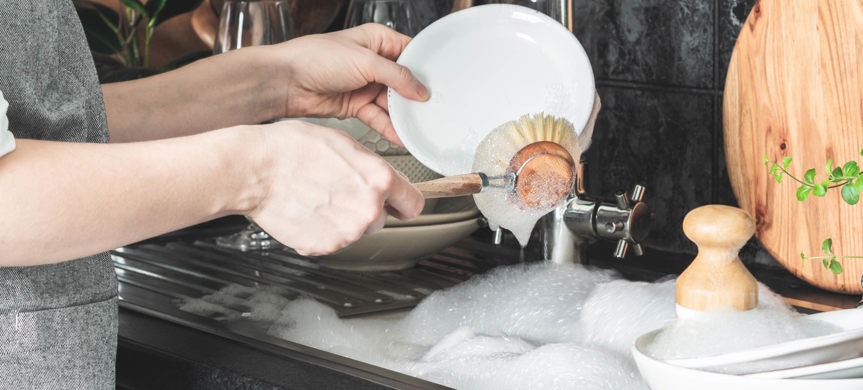The test is part of the NordQual Project driven by consumer organizations in Sweden, Denmark and Finland and financed by the EU Consumer Program.
This is the second of three tests on household products to compare the products’ function, ingredients, labeling and packaging. We are also investigating so called “dual quality,” whether products might look the same in different countries but have different ingredients.
How we tested the products
In the laboratory we ran tests on foaming and degreasing. Foam is produced by anionic surfactants and can be an indicator of cleaning ability. However, other surfactants produce less foam but still have good cleaning ability. Therefore, we did another degreasing test that was independent of foaming.
In the first test, a robot washed dishes to see how many could be washed before the foam disappeared. In the second, a robot made five scrubs on a greasy plate to assess how much of the grease washed away.
We also inspected the products’ ingredients lists – both on the bottles and on the producers’ websites – and the recycled content or recyclability of the bottles. Problematic chemicals, incomplete ingredients information and hard-to-recycle packaging reduced the final product scores.
Some interesting results
- There is a wide variation in formulas for hand dishwashing detergent leading to a big difference in how much they produce foam. The degreasing abilities of the detergents showed much less variation, most of the products adequately cleaning greasy plates.
- Two products contain suspected endocrine disruptors – Lidl’s W5 Platinum Original in Sweden and Vel Ultra Ekstra Drøj in Denmark.
- Denmark had nearly double the number of Asthma-Allergy labelled products in our test than Finland and Sweden. 40 percent of Danish products had the Asthma-Allergy label versus 21 and 22 percent in Finland and Sweden, respectively.
- One of the Finnish products required five times the dosage compared to other products.
Here are the problematic chemicals:
There are various reasons to consider chemicals in hand dishwashing products. First, consumers often expose their skin to these products when washing dishes or their hands. While the exposure to chemicals in hand dishwashers is not generally problematic alone, it contributes to the body’s total exposure to problematic chemicals – the cocktail effect – which can aggravate risk for health impacts such as allergies or hormonal interference. Secondly, there can be a risk that some chemicals end up in the environment depending on how the wastewater is handled.
All of the problematic chemicals we have highlighted in this test are avoidable, having little to no effect on the cleaning performance of the product. The problematic chemicals were not found in the products with the Nordic Swan or the Asthma & Allergy labels.
Other chemicals:
- Perfumes – can cause a skin allergy. Limonene, geraniol, and linalool are just some of the sensitizing fragrances that can cause skin allergy. For those who wish to avoid perfumes, there are many perfume-free products available.
- Suspected Endocrine Disruptors – these chemicals have shown potential to disrupt the hormone system and are under further investigation in the EU. Two suspected endocrine disruptors - benzyl salicylate and butylphenyl methylpropional - were found in some hand dishwashing detergents. Butylphenyl methylpropional is also suspected of damaging fertility and the unborn child. Suspected endocrine disruptors are forbidden in Nordic Swan and EU Ecolabel products.
- Allergenic preservatives – preservatives are used to extend the life of the product. Some preservatives can cause a skin allergy, including DMDM hydantoin and isothiazolinones such as methylisothiazolinone, whereas other preservatives are considered safer. The allergenic preservatives can be avoided by choosing a product with the Asthma-Allergy label. They are also either banned or restricted to low concentrations in Nordic Swan and EU Ecolabel products.
- Environmentally problematic substances – these chemicals can be harmful to aquatic life with long-lasting effects if they are released into the environment. Nordic Swan and EU Ecolabels restrict certain environmentally problematic substances including EDTA, limonene, and methylisothiazolinone.
Other chemicals:
- Colorants – are often added to products to make the detergent in the bottle a certain color but serve no purpose in cleaning the dishes.
- Enzymes – soaking dishes makes cleaning them easier, and the effect can be enhanced by enzymes which are found in some hand dishwashing detergents. The enzyme amylase breaks down starch (for instance oatmeal) and the enzyme protease breaks down proteins (for instance egg) when a dish is soaked for a longer time. However, the tests we ran did not account for the effect of soaking dishes in the product.
Ingredients, warnings and protection information
According to EU law, product ingredient information needs to be available on the company’s website if the ingredients are not all written on the bottle. In about half the cases, the ingredient information on the website was hard to find or not there.
Hazard labels on the bottle were not always reliable when it comes to presence of problematic chemicals. Recommendations to wear gloves or eye protection while washing dishes, or to wash hands after doing the dishes was also not representative of the level of risk from the ingredients. For example, Vel Ultra Ekstra Drøj claimed to be "mild on hands" but contained a known allergenic perfume and warned to “rinse with plenty of water” on contact with skin.
Another common phrase on the bottles is "dermatologist tested". However, it is a meaningless marketing statement as there are no strict requirements for that phrase.
22 mars, 2021

